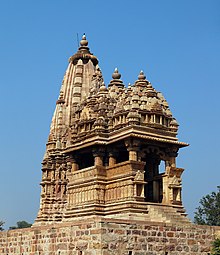Javari Temple, Khajuraho
This article needs additional citations for verification. (March 2012) |
| Javari Temple | |
|---|---|
जावरी मंदिर | |
 Javari temple at Khajuraho | |
| Religion | |
| Affiliation | Hinduism |
| District | Chattarpur, Khajuraho[1] |
| Deity | Vishnu[1] |
| Location | |
| Location | Khajuraho[1] |
| State | Madhya Pradesh |
| Country | India |
| Geographic coordinates | 24°51′11″N 79°55′10″E / 24.85306°N 79.91944°E |
| Architecture | |
| Creator | Chandella Rulers |
| Completed | C. 975 and 1100 A.D.[1] |
| Temple(s) | 1 |
The Javari Temple in Khajuraho, India, is a Hindu temple, which forms part of the Khajuraho Group of Monuments, a UNESCO World Heritage Site. It was built between c. 975 and 1100 A.D.[1]
The temple is dedicated to the Hindu deity Vishnu.[1] The main idol of the temple is broken and headless(see image).[2]
Location
The temple is located in the eastern area of Khajuraho.[1] It is near to and visible from Vamana Temple, and at a distance of about 200 meters (south)[1] from it.
Architecture
It has well-proportioned architecture, with a sanctum,[1] vestibule,[1] mandapa[1] and portico,[1] but without pradakshinapatha. It has remable Makara Torana[1] (Capricorn Arch) and shikhara (top). It has three bands of carved sculptures on the outer wall. The temple has a close resemblance[1] with Chaturbhuja Temple, also at Khajuraho.
Main idol
The main idol (of Vishnu[1]) of the temple is broken and headless.[2]
Makara (Capricorn) Arch
Temple has beautiful Makara[1] (Capricorn) Arch at the entrance porch (also seen in image).
Entrance of sanctum
The entrance gate of sanctum has sculptures depicting nava-graha on the top. Along with nava-graha sculptures, sculpture of the Hindu deities Brahma, Vishnu and Shiva can also be seen.
Sculptures
The temple has two bands of sculpture on the outer wall (see image).[3]
Gallery
-
Main Idol
-
Makar (Capricorn) Arch
-
Roof of the Temple
References
External links
- M.P. Tourism Website, Official Website of Madhya Pradesh State Tourism Corporation, Khajuraho
- Archaeological Survey of India, Bhopal Division, Index Page for Khajuraho - Chhatarpur
- Archaeological Survey of India, Bhopal Division, Javari Temple, Khajuraho




